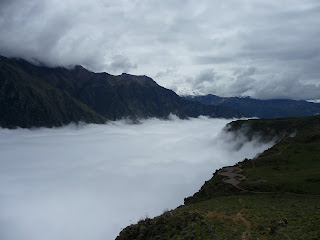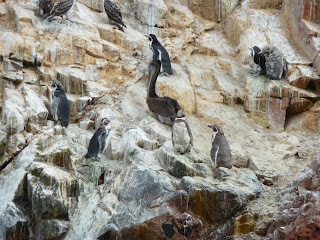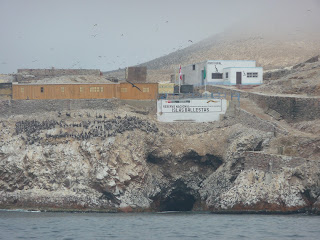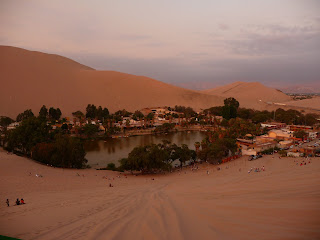Otra vez tengo que empezar con un anuncio técnico: como el problema con las fotos ya está resuelto, cambié todas las fotos en los posts anteriores para unas que tomé yo durante el viaje - si queréis, podéis checkearlos.
En Bolivia, la primera intención era visitar el desierto de Salar de Uyuni. Desafortunadamente, como había tanta lluvia y tantos problemas en la carretera, eso no funcionó y todas las agencias nos dijeron que no es una buena idea ir allí en estos días. Así me quedé en La Paz que como ciudad ni es super interesante ni organizada y las posibilidades son bastante limitadas. Su altitud es algún 3.600 metros y eso se siente cuando estás caminando en sus calles muy empinadas.
 |
| Vista de La Paz con Pico Illimani (6438 m) escondido en los nubes |
Así teníamos que reorganizarnos y decidimos que vamos a hacer el famoso ruta ciclista El Camino de la Muerte. El nombre normal de esta ruta es el Camino a Los Yungas y es un camino más o menos de 80 kilómetros que une La Paz con la región de Los Yungas al noreste.
El camino es de triste fama porque históricamente tenía las peores estadísticas en tema de accidentes mortales. Eso no es una gran sorpresa cuando sabemos que es de un ancho de un sólo carril (3 m en algunos lugares), no hay guardarraíles en ningunas partes y en la zona son habituales la lluvia y la niebla. El 24 de julio de 1983, un bus se desbarrancó precipitándose en un cañón, produciendo la muerte de más de cien pasajeros en el peor accidente vial de Bolivia.
 |
| El Camino de la Muerte - antes de empezar |
El problema es que en Bolivia, hay otro deporte nacional y no es el fútbol: es hacer bloqueos. Cuando el precio del petroleo sube, hacen un bloqueo. Cuando el transporte público no pasa en el barrio, hacen un bloqueo, etc. Cuando empezamos el primer día, estábamos bloqueado durante más de tres horas por un bloqueo y nos dijeron que van a quitarlo. En el cuarto hora, nos dijeron que no van a hacerlo... Así teníamos que volver a la ciudad con mucha frustración (y volviendo, teníamos que dar una vuelta muy grande por culpa de un bloqueo que formaron atrás de nosotros mientras tanto). Finalmente, solamente pudimos hacer el tour el día siguiente.
Normalmente, los tours empiezan en la altitud de 4.700 metros y se puede bajar más de 3.000 metros hasta la ciudad de Yolosa. En nuestro caso, nevaba tanto y hacía tanto frío que nuestro guía sugirió que empezamos solamente en la boca del camino antiguo. Todo el mundo estaba de acuerdo.
 |
| Ciclista en el Camino |
De verdad, probablemente El Camino habría dado mucho más miedo en bus.
Como todavía me quedan unos días, decidí que la última etapa de mi viaje será un intento para ir al cumbre de Huayna Potosí (6088 m) cerca de La Paz.
-------------------------------------------------------------------------------------------------------------
Once again, I have to start with a technical announcement: since the virus problem with the photos is now resolved for once and all, I've changed back all the photos in the former posts to ones which I have taken during my trip - check them out if you feel like it.
In Bolivia, my first intention was to visit the desert of Salar de Uyuni. Unfortunately, since it was very rainy and there were loads of problems on the road, it did not work out and all the tourist agencies were advising against going there these days. So this was how I stayed in La Paz which is neither a super interesting nor a super organized city and the possibilities are rather limited. Its altitude of 3.600 meters also makes you feel it when you're walking on its really steep streets.
So we had to reorganize and we decided that we'll do the famous bike ride of The Death Road. Its normal name is The Yungas Road and it is a 80-kilometer long route which connects La Paz with the region Yungas in the northeast.
It has its bad reputation due to its historically bad statistics in terms of mortal accidents. It is not a big surprise if we think about the fact that it's a one-lane road which is only 3 meters wide at certain points, the are no barriers and the area has a lot of rain and fog. On 24 July 1983, a bus tipped over the edge and fell in the canyon, killing all the 100+ passengers aboard in the worst road accident of Bolivian history.
These days, road traffic does not pass here anymore as they have a connection which is newer and safer. The vast majority of people come here now by other means: by bike.
The problem is that in Bolivia, there is another national sport which is not football: making roadblocks. The price of petrol went up? Let's make a roadblock! Public transport does not cross our neighbourhood? Let's make a roadblock! And so on. When we started off the first day, we came to a stall at a certain point and had to stay there for more than three hours. It was due to a roadblock which we were informed is going to be lifted. In the fourth hour, we were informed that this is not gonna be the case. So totally frustrated, we had to go back to the city without doing anything - and on the way back, we had to make a massive detour due to a roadblock which they spontaneously formed behind us while we were waiting... Finally, we could only do the tour the next day.
Before doing it, I thought that The Death Road is gonna be really difficult and dangerous. In reality, it's not at all. If you're not doing crazy things and are not speeding excessively, nothing will happen and you will enjoy it very much since the views are really breathtaking. Doing it at the rainy season also has the advantage of seeing all the waterfalls in full motion - you even have to pass under certain ones every now and then which gives you a nice freezing shower.
Actually, I think it must have been much scarier doing it by bus.
Since there are still a few days left, I decided that the last part of my trip will be an attempt for the peak of Huayna Potosí (6.088 m) which is located pretty close to La Paz.



















